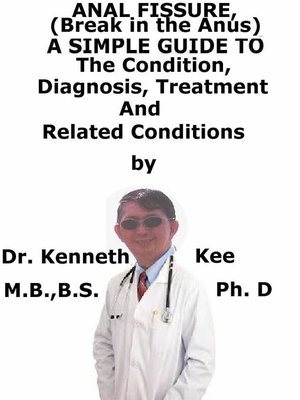Anal Fissure, (Break in the Anus) a Simple Guide to the Condition, Diagnosis, Treatment and Related Conditions
ebook
By Kenneth Kee

Sign up to save your library
With an OverDrive account, you can save your favorite libraries for at-a-glance information about availability. Find out more about OverDrive accounts.
Find this title in Libby, the library reading app by OverDrive.



Search for a digital library with this title
Title found at these libraries:
| Library Name | Distance |
|---|---|
| Loading... |
An anal fissure is a medical disorder that involves a small split or tear in the thin moist tissue (mucosa) lining the lower rectum (anus).An anal fissure is a small tear of the sphincter around the back passage (anus).Although the tear of an anal fissure is normally small (less than a centimeter), it can be very painful.This is because the anal nerves can sense pain easily.The pain becomes worse when the patient passes stools (feces) and for an hour or so after passing feces.Frequently an anal fissure will bleed a small amount.The patient may notice blood after he or she passes feces.The blood is normally bright red.A small amount of blood may be observed on the toilet paper or coating the feces.Anal fissures are common, both in children and in adults.They are not normally dangerous, but they are sore and can be distressing, particularly for children.In most patients the anal fissure will heal within 1 to 2 weeks or so, just like any other small cut of the skin.Some fissures will not heal so fast.A fissure that persists for more than 6 weeks is called a chronic anal fissure (chronic means persistent).This is rare, but treatment can still cause healing.CausesThe main cause is constipation and the passage of a hard stool.In adults, fissures may be caused by passing large, hard stools, or having diarrhea for a long time.Other factors are:1. Decreased blood flow to the area in older adults2. Too much tension in the sphincter muscles that control the anus3. Anal fissures are also common in women after childbirth4. Anal fissure occurs as part of another condition in persons with Crohn's disease or an anal herpes infection.It occurs in babies as well as adultsAnal fissures are very common in infants, but they may occur at any age.The rate of anal fissures drops with age.Fissures are much less frequent among school-going children than in infants.Once a fissure has formed pain when passing feces can tighten the anal tone further.This induces pain and worsens symptoms causing a vicious cycle to be set up.Constipation can make an anal fissure more likely to form.In about 10% patients, the anal fissure happens during childbirth.Sometimes an anal fissure occurs if the patient has bad diarrhea.SymptomsAnal fissures may cause painful bowel movements and bleeding.There may be blood covering the outside of the stool or present on the toilet paper (or baby wipes) after a bowel movement.Symptoms may start rapidly or form gradually over time.A crack in the anal skin that can be seen when the part of the anus is stretched slightly (the fissure always occurs in the middle)1. There is usually a tear in the anal with sometimes overlapping flesh covering the fissure.2. Itch3. Bleeding may occur.How is an anal fissure diagnosed?The doctor will usually diagnose an anal tear (fissure) by the typical symptoms and by examining the skin around the back passage (anus).Treatment of Anal Fissure:In most patients the tear (fissure) heals within a week or so, just like any other small cut or tears to the skin.Treatment aims to ease the pain and soften the stools (feces) whilst the fissure recoversRelieving pain and discomfort1. Warm baths2. An ointment or cream that has an anesthetic such as lidocaine may help to ease the pain.3. A cream or ointment that has steroid medicine inside may be prescribed by a doctor if there is a lot of inflammation (swelling) around the fissure4. Avoid constipation5. Eat more fiber and fruits6. Drink more waterIf the patient uses glyceryl trinitrate (GTN) ointment to the anus, it loosens the muscle around the anal sphincterSurgery is a choice if the fissure does not heal despite the above treatments.TABLE OF CONTENTIntroductionChapter 1 Anal FissureChapter 2 CausesChapter 3...







